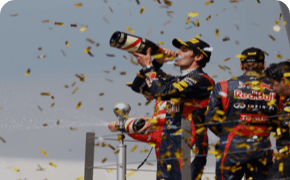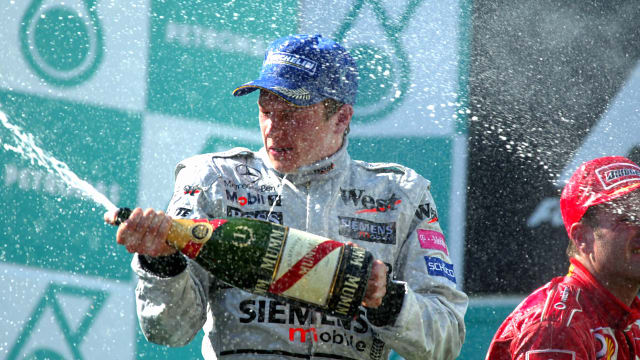For anyone accustomed to weather forecasts being vague, inconsistent things, hearing the Formula One equivalent can be… surprising. Race engineers don’t supply their drivers with nebulous possibilities, instead they deal in specifics, relaying precise information: how many minutes until rain starts falling; which corner it hits first; how intense; for what duration. Points - sometimes races - are won and lost based on interpreting what the weather is going to do and acting accordingly. But how is the information generated in the first place - and why doesn’t everyone else get this sort of service?
The answer lies in localisation. Formula One has its own travelling weather service and, rather than looking at the big picture, it focuses on a very narrow patch of sky, tracking storms - even individual clouds - on approach to the circuit. In operation it isn’t very different to the sort of micro-forecasting that might be used by an airport or perhaps a ski resort - though it does have the added complication of moving to a new location every couple of weeks.
Mercedes' Lewis Hamilton gets caught in the deluge during qualifying in Hungary. © Sutton Images
The Weathermen
“It’s maybe a tonne of equipment that has to be carried around the world,” says meteorologist Steffen Dietz. “The big piece of equipment is the weather radar which we assemble on-site. We’ll locate it somewhere in the vicinity of the track, but high up if possible. At Spa it’s in a cow pasture, but somewhere like Interlagos we place it on the top of a skyscraper, 27 floors up. It needs to be portable.”
Dietz works for Ubimet, the Austrian forecaster contracted to supply weather data to race control and the 11 teams. Ubimet dispatch two meteorologists to every Grand Prix where they set up trackside and paddock weather stations, the radar, and other assorted meteorological equipment. These tools provide the raw data which, fed through Ubimet’s forecasting algorithms, in turn provide the garages with real-time weather updates.
“The more information we give to teams, the happier they are,” says Dietz. “Via a web portal we provide the radar but also the station data, the different model forecasts and a live ticker during the track sessions. For rainfall, our aim is to forecast to the minute when rain will arrive, when it will leave, how much rain will fall and so on.”
The weather radar screen, provided by Ubimet to the teams, as seen during the rain-hit FP2 session at Austin last year. © LAT Photographic
When prediction gets tough…
While several classic tracks on the current F1 calendar are famed for unpredictable weather (and the dreaded phrase ‘microclimate’) Dietz argues the more difficult circuits to forecast tend to be the rather less venerable.
“Common consensus says places like Spa and Silverstone are tricky because the weather changes minute-by-minute. In reality, that’s not usually the case. In Europe you get frontal systems moving through that produce active weather. To people on the ground the change may look sudden, but when the weather is ‘connected’ like that, you can see how it’s moving, study the rain echoes and understand what’s going to happen according to the models.
“In the tropics, however, it’s not so easy. Predicting rain somewhere like Singapore or Sepang is tough because it doesn’t have those weather fronts, instead you have a daily development of cloud. It’s going to develop into a thunderstorm at some point - but you can’t say where or when that will be. The closest analogy is staring into a pan of water coming to the boil: you know it’s going to bubble soon but you don’t know where the first bubble is going to appear. Tropical weather somewhere like Sepang is usually like that: heavy rainfall is coming - but it could hit the track or fall 5km away.”
In tropical countries like Malaysia, wet weather can bubble up suddenly. © Sutton Images
The Race Engineers
The weather team usually arrive at a circuit on Monday and spend the start of the week constructing and calibrating their equipment - but teams’ use of weather data starts long before this, before cars leave the factory.
“We’ll start thinking about it a week or more before the race,” says Mark Temple, Fernando Alonso’s race engineer at McLaren. “We’ll look at the long-range forecasts to gather data on likely air temperature. If we’re going to Hungary, for example, and the indications are that it will be 45°C rather than 25°C, we’ll set up the baseline cooling package for the car accordingly. We’ll track how the forecast changes as the race draws nearer, and start using the official Ubimet forecast on Wednesday.”
Sometimes the best way to check for rain is an upturned hand from out of the pit gantry. © LAT Photographic
The Strategists
Closer to the event, the weather forecast has a habit of colouring strategy decisions if there’s a hint of rain around. It would seem likely that the beginning of a shower is simply something to be reacted to, rather than incorporated into a plan - but this really isn’t the case.
“You have to take the likelihood of rain into account - so we’re very interested in the forecast,” says Sarah Courtenay, strategy analysis team leader at Red Bull Racing. “One of the key things is the rule that, if you use a wet tyre, you’re then not obliged to run both dry compounds. For instance, if there is any risk of rain, we might choose not to run the slower tyre until later in the race, to avoid using it unnecessarily - you certainly might start to change your strategy plans according to what the weather data is telling you.”
If wet tyres are used in a race, such as at Monaco this year, then teams are not obliged to run two dry-weather compounds - and that has big strategic implications. © Sutton Images
Weather watchers
Dietz says Ubimet need boots on the ground because “it isn’t possible to provide this level of information from a remote location. Somebody has to be here, has to look at the sky, has to feel it - and be able to concentrate completely on one single cloud, that might hit the track or miss by 500m.” Conversely, the weather service having staff in place gives teams the freedom to monitor the information remotely. Courtenay can see weather reports from Red Bull’s Ops Room at their Milton Keynes factory, while McLaren will detail a member of staff in the UK to stay up to date with the forecast during race sessions, and pass information on to the race engineers who are usually the sole conduit of information for the drivers.
Temple, however, also likes to keep an eye on the radar himself. “It’s helpful to have both,” he says. “Looking at the radar is useful. It plays back the last half-hour, so can give you a good idea of how the rain is developing and changing. It’s hard, though, to use it to make a precise judgement. Having that accompanied by a sentence or two saying ‘heavy rain in five minutes’ is useful as well, particularly in qualifying because there’s so much going on to get the car in and out of the garage. In the race there’s a bit more time, so I would tend to look at the radar more myself. It might not define what we do but it will help me build a picture of what’s going on.”
It’s a rather more sophisticated method of operation than F1’s original technique of forecasting, which involved team members posted as spotters at vantage points upwind, armed with a walkie talkie or, as technology improved, a mobile phone.
Some teams still do this. McLaren, generally, don’t - but there are other old-school methods for understanding what’s going on. “Watching the TV feed is really useful because the TV tends to focus on drama,” says Temple. “If the director shows umbrellas going up in a grandstand at Turn 5, that’s a good clue. It’s also quite a good idea to look up occasionally. You can be staring at a radar image on screen and not notice rain is falling in the pit lane.”
Unsophisticated a method though it is, the sight of umbrellas going up in the grandstands can often alert the teams to rain falling at different points around the track. © Sutton Motorsport Images
The Drivers’ Call
The information, of course, only gets a team and a driver so far; using the information is what makes the difference between being caught out by changing weather and taking full advantage of it. It’s not just a question of making good decisions, but also knowing with whom those decisions reside.
“In a race situation it often depends on whether it’s getting wetter or drier,” says Temple. “When it’s getting wetter, the driver really needs to make the call about when to change tyres because he’s the one who can feel when it’s too wet for what he has.
“It’s a bit different when it’s drying out. Of course, the circuit tends to dry more slowly than it gets wet, and it’s harder for the driver to assess. We have the advantage of being able to see what other people are doing. We can look at their lap time and see how they’re doing and pass along that information to help the driver understand what’s happening.”
Having information to complete the tactical weather picture means it’s less and less common for teams to be caught out by a sudden change in conditions. Fortunately for fans it doesn’t detract from the spectacle: it’s one thing forecasting the weather, another entirely to drive quickly in it...
In a race situation when the track is getting wetter, the driver must decide when it's time to switch tyres. When it's drying, the team can help make the call. © Sutton Images



















